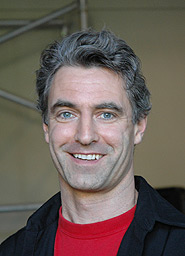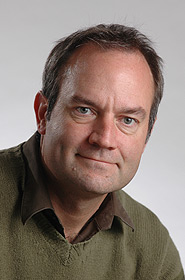Berkeleyan
Digital-media grants will fund new projects
By exploring air pollution in Cairo and Los Angeles, and teaching English via cell phone in India, two Berkeley researchers will advance the development of digital media for learning
![]()
| 27 February 2008
An online mystery game in which student sleuths will monitor air pollution in both South Central Los Angeles and Cairo, and a project using cell phones to teach English to children in India, have won funding for two Berkeley professors.
| See a full list of winning projects in the Digital Media and Learning Competition online here. |
The air-pollution project, designed by Greg Niemeyer, an associate professor in art practice and film studies, and the India experiment, headed by John Canny, professor of electrical engineering and computer sciences, are among 17 projects recently chosen by the Digital Media and Learning Competition and funded by the John D. and Catherine T. MacArthur Foundation.
Each Berkeley project will receive the top allocation of $238,000. All of the projects, chosen from 1,010 applications, are expected to produce promising innovations in the use of digital media for learning. They will be administered by the Humanities, Arts, Science, and Technology Advanced Collaboratory (HASTAC), a consortium of more than 70 public and private research institutes across the human and computer sciences.
"We are at a crucial historical juncture where technological, scientific, and cultural changes leave us with both great responsibility and great opportunity," says Cathy Davidson of Duke University, a co-founder of HASTAC.
Another co-founder, David Theo Goldberg of the University of California's Humanities Research Institute, says, "These awards, and the competition generally, have identified inventive technologies by which learning is networked, expanded, interactive, and engaged. This is the give-and-take of learning at its very best."
 Greg Niemeyer (Wendy Edelstein photo) |
In early July, Niemeyer's "Black Cloud" mystery game will be launched at Manual Arts High School in Los Angeles by English instructor Antero Garcia, with classroom instruction and field trips. In Egypt the game will be played at El Sawy Cultural Center during the peak of the country's pollution season, which coincides with the fall rice harvest. Niemeyer says that it was learning about the "black cloud" of pollution that hits the Egyptian capital each October and November that inspired the game's name.
Egyptian students will scour their neighborhoods for hidden wireless air-quality sensors that are dispatching real-time information about local pollution. They must learn to read graphs, associate air-quality data with human activities, and develop an understanding of the local pollution landscape. They also will interview residents, post songs and video clips online, maintain a blog about their work, and document socioeconomic elements of pollution. One student will receive a $5,000 stewardship award to give to a local climate-improvement group of his or her choosing.
Niemeyer hopes to license the game for use in high schools across the United States. He also intends to post the basic game online, along with links to the test schools' related websites, to illustrate different cultures' social responses to environmental conditions.
Canny's project, Mobile and Immersive Learning for Literacy in Emerging Economies, uses educational games to help improve literacy among children in rural India.
"This project focuses on learning English, which is one of two national languages in India and considered a key to socioeconomic success, but we believe the lessons could be transferred to other languages as well," says Canny.
 John Canny (Peg Skorpinski photo) |
Canny points out that it is not effective to parachute Western-influenced programs into rural areas where children may have had little exposure to video games. That is why the project's goal is to develop culturally appropriate digital learning games by taking inspiration from traditional games played in rural villages.
Mobile phones were chosen as the platform for the games because they are more prevalent and accessible in developing countries than computers. Says Canny: "Cell phones are the PCs of the developing world. It's the fastest-growing technology platform in the region. Roughly half of school-age children in India do not attend school regularly, primarily because they are kept home to help with domestic or farm work. We think that using cell phones as a platform could help children maintain a connection to educational resources when they are out of the classroom."
Notably, the majority of games will be audio-only so that they can be used by a child who may be engaged in repetitive, manual work.
[For more on this project, see "The Promise of Berkeley".]
Both Berkeley grant recipients are affiliated with the campus's Center for New Media and are researchers at the Berkeley Institute of Design, a campus research group that fosters an interdisciplinary approach to innovative design that spans human-computer interaction, mechanical design, education, architecture, and art practice.

